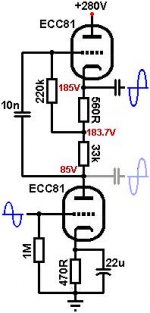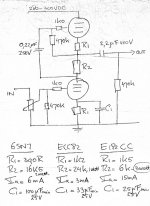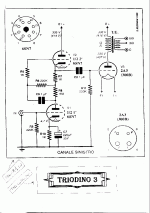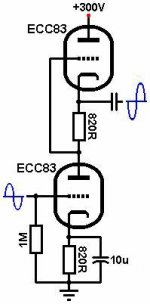Voltage gain will be approximately equal to mu for the lower valve.
To change from ECC81 to 6SN7 you need to choose new operating points and calculate new component values. Or find and copy an existing design.
To change from ECC81 to 6SN7 you need to choose new operating points and calculate new component values. Or find and copy an existing design.
Hi!
Without some more information what you want to do and why you think a mu follower is a good idea for your application, nobody will be able to give good advice.
Also why not just try the configurations you digged up and report your findings?
Thomas
Without some more information what you want to do and why you think a mu follower is a good idea for your application, nobody will be able to give good advice.
Also why not just try the configurations you digged up and report your findings?
Thomas
Hi,
Don't interested in the last posted schematic because have an output impedance of 1500 ohms & I need 300 ohms or less to use as headphone amp for my Sennhs HD600
Felipe
Don't interested in the last posted schematic because have an output impedance of 1500 ohms & I need 300 ohms or less to use as headphone amp for my Sennhs HD600
Felipe
Hi!
300 Ohms is very low. Do you really want to use a mu-follower for that?
You will need a huge coupling cap. 100uF already has an impedance of 80 Ohms at 20Hz.
Even if you accept a higher roll of frequency, you'd still need at least 50uF
Thomas
300 Ohms is very low. Do you really want to use a mu-follower for that?
You will need a huge coupling cap. 100uF already has an impedance of 80 Ohms at 20Hz.
Even if you accept a higher roll of frequency, you'd still need at least 50uF
Thomas
Thanks Thomas, I'm exploring other OTL alternatives.
You will not be able to drive 80 ohms phones to reasonable levels using a single tube like the 6SN7 or ECC88 in an OTL configuration. To output 10mW into an 80 ohm load requires a peak current of nearly 16mA which means the idle current of an OTL stage has to be at least this value. The thing is you only need a voltage of 900mV so you are asking a tube to produce a high current at a low voltage, exactly the opposite of what it does well. The answer is a transformer and with a suitable turns ration an ECC88 will happily drive a pair of 80 ohms phones to high levels at low distortion and with plenty of headroom.
Cheers
Ian
Phones are 300 ohms and I want to avoid OTL due to expensive prices. If necessary I can use more tubes.
TIA
Felipe
TIA
Felipe
What about two 6N7 / 6N7C (Soviet) on top of each other? Or 6H6P-I ?
I don't have these tubes.
Phones are 300 ohms and I want to avoid OTL due to expensive prices. If necessary I can use more tubes.
TIA
Felipe
Oops, must have been thinking of another thread when I used 80 ohms in my calculation. For 10mW into 300 ohms you need a peak current of just over 8mA. You might just about get this from an ECC88 SRPP.
If you use 100 ohm cathode bias resistors and a 200V supply you can run at an idle current of 15mA and keep within the allowed plate dissipation and output 2.66 volts rms into a 300 ohm load with about 1.6% distortion according to LTspice which is just under 25mW. For 10mW you need about 1.75V rms which this circuit will do into 300 ohms with a distortion of just over 1%.
In practice I have found that LTspice overestimates the second harmonic distortion and underestimates the third.
You could reduce the distortion by an order of magnitude with suitable negative feedback.
Cheers
Ian
Ian, do you refer schematic post 5?
No, I was referring to an SRPP.
Cheers
Ian
Like this?
Yes, but ECC88, 200V supply and 100 ohm cathode resistors.
Cheers
Ian
- Status
- Not open for further replies.
- Home
- Amplifiers
- Tubes / Valves
- 6sn7 mu-follower





